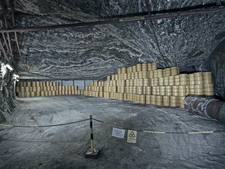Disposed radioactive waste
From 1971 to 1991 and from 1994 to 1998, altogether 36,754 cubic metres of low-level and intermediate-level radioactive waste were disposed of in the Morsleben repository for radioactive waste (ERAM). This also includes 6,621 sealed radiation sources. About sixty per cent of the inventory currently being stored originates from the time after the repository had been taken over by the BfS in the course of reunification, starting on 3 October 1990.
Origin of the waste and types of waste
The data on the waste that has been disposed of and stored intermediately has been documented and archived. The major part of the radioactive waste originates from the operation of nuclear power plants and from the decommissioning of nuclear installations. Other waste originates from the nuclear industry, research institutions, federal state collecting depots or, respectively, directly from small waste producers and other users (e.g. the Federal Armed Forces and medicine).
The permanent operating licence of 1986 permitted the storage of radioactive waste in solid and liquid, aqueous form and in the form of sealed radiation sources. Until 1990, the liquid, aqueous waste was solidified underground directly on the repository site (in situ). Later on, this technology was no longer applied. It was only permitted to dispose of special radioactive waste in Morsleben (such as waste that may rot or ferment, toxic waste) and, since 1990, this also included liquid waste, after it had been immobilised. In corresponding operational provisions it was regulated how this immobilisation was to be achieved.
Among others, the following forms of radioactive waste existed:
- building rubble
- contaminated soil
- cemented, pressed and unpressed mixed waste (e.g. contaminated working equipment and laboratory waste, protective clothing, tools, plastic foils, filter and insulation materials)
- metallic waste (such as fittings, piping, cables)
- combustion products
- cemented wash water, solutions and concentrates
- sealed radiation sources
Furthermore, solely low-level and intermediate-level radioactive waste was allowed to be disposed of. For this purpose, the radioactive waste was classified in six radiation protection groups, based on the respective gamma dose rate, activity concentration or activity. Depending on the type of waste, it was permitted to dispose of certain radiation protection groups only.
Emplacement areas and emplacement techniques
All emplacement cavities are located on the 4a-, 4- and 5a-level of the Bartensleben mine. Areas in the northern field, the eastern field, the southern field, in the western field and in the central part were available for this. The radioactive waste is stored at least 480 metres below the surface.
Various techniques were applied to dispose of the radioactive waste. The radioactive waste was generally packed into standardised containers, such as 200- to 570-l drums and cylindrical concrete containers. Special packaging (such as PE foil or cardboard) was used for bulky waste. A very small part of the waste was disposed of without additional packaging.
Depending on the condition of the waste, it was stacked or dumped. Until 1990, liquid radioactive waste was additionally solidified in situ with the aid of brown coal filter ash and transferred into a state suitable for disposal. When the in-situ solidification of liquid waste started, contaminated solutions got to the 5th to 7th level. Meanwhile these have evaporated. The radioactive materials deposited at the walls and on the ground and have solidified meanwhile.
Activity of the waste disposed of
From 1971 to 1991 radioactive waste with a total activity of 180,000 gigabecquerels and, from 1994 to 1998, waste with a total activity of 91,000 gigabecquerels was disposed of. Due to the radioactive decay, the activity of the waste decreases over time. At the end of 2014, the total activity of all waste disposed of in Morsleben amounted to about 93,000 gigabecquerels. This means that during that period of time 93,000,000,000,000 (93 trillions) of nuclei decayed and the activity decreased to about one third of the initial value. For comparison, the activity of waste stored intermediately in the Morsleben repository amounted to ca. 170,000 gigabecqerels on 31 December 2014.
Operational radioactive waste (own waste)

![]() Own waste in the western field
Own waste in the western field
The last radioactive waste was taken to Morsleben on 28 September 1998. Even if no more external radioactive waste is disposed of in Morsleben, there is still some waste arising in the control area that may be contaminated – so-called own waste. An example of this are air filters from the diesel-driven vehicles used in the control area. Proof that these are not radioactively contaminated can only be furnished with great effort that cannot be justified. For safety reasons, such air filters therefore remain in the repository as own waste and are professionally conditioned in a drum. The same applies to radioactive waste arising in future in the process of decommissioning. Since emplacement operations stopped, ca. 30 cubic metres of own waste per year on average have been disposed of.
State of 2016.04.26


